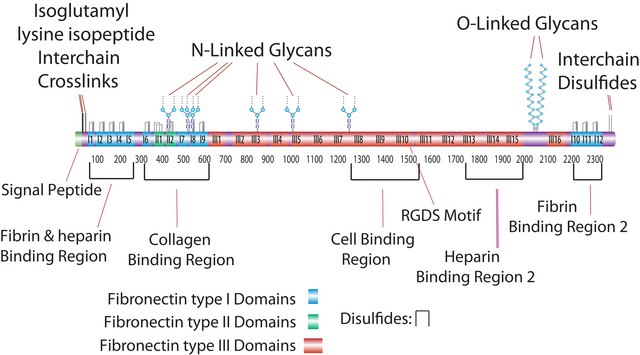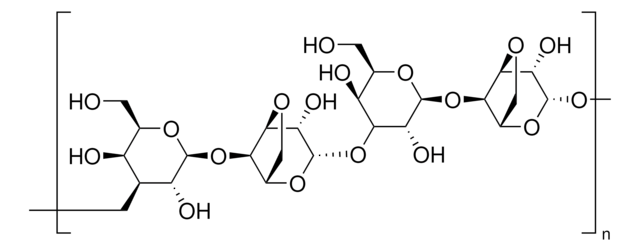F8141
Fibronectin-like Engineered Protein Polymer-plus genetically engineered
powder, sterile; autoclaved, BioReagent, suitable for cell culture
Synonym(s):
ProNectin® F Plus
Sign Into View Organizational & Contract Pricing
All Photos(1)
About This Item
UNSPSC Code:
12352202
Recommended Products
recombinant
expressed in E. coli
Quality Level
sterility
sterile; autoclaved
product line
BioReagent
form
powder
mol wt
~110 kDa by SDS-PAGE
packaging
pkg of 1 mg
technique(s)
cell culture | mammalian: suitable
solubility
H2O: 1 mg/mL (stable for 12 mo. at RT)
shipped in
ambient
storage temp.
room temp
Application
Recommended for use as a cell culture substratum
at 2-10 μg/cm2.
at 2-10 μg/cm2.
Other Notes
Positively-charged, protein polymer which incorporates multiple copies of the RGD cell attachment epitope from human fibronectin between repeated structural peptide units.
Linkage
Similar to F5022 but more highly charged polymer which encourages better adhesion in many cell lines.
Reconstitution
Dilutions can be made to a working concentration with balanced salt solution; stable up to 2 days at RT. Coated labware is stable at least 4 months at RT.
Legal Information
ProNectin is a registered trademark of Sanyo Chemical Industries, Ltd
Storage Class Code
11 - Combustible Solids
WGK
WGK 3
Flash Point(F)
Not applicable
Flash Point(C)
Not applicable
Personal Protective Equipment
dust mask type N95 (US), Eyeshields, Gloves
Regulatory Information
常规特殊物品
Choose from one of the most recent versions:
Already Own This Product?
Find documentation for the products that you have recently purchased in the Document Library.
Receptor-specific serum-free cell attachment using a highly stable engineered protein polymer.
Esty, A.
American Biotechnology Laboratory, 44-44 (1991)
Sara Riccardi et al.
Frontiers in genome editing, 4, 846669-846669 (2022-05-03)
Neuronal differentiation is a complex process whose dysfunction can lead to brain disorders. The development of new tools to target specific steps in the neuronal differentiation process is of paramount importance for a better understanding of the molecular mechanisms involved
Evan A Thackaberry et al.
Investigative ophthalmology & visual science, 58(10), 4274-4285 (2017-08-30)
Poly(lactic-co-glycolic) acid (PLGA) inserts have been successfully developed for the treatment of posterior eye disease as a means of reducing injection frequency of intravitreally administered therapeutics. PLGA microspheres are also of interest for the delivery of intravitreal drugs, since they
Julia Ghelman et al.
Glia, 69(11), 2699-2716 (2021-07-30)
Oligodendroglial progenitor cells (OPCs) are highly proliferative and migratory cells, which differentiate into complex myelin forming and axon ensheathing mature oligodendrocytes during myelination. Recent studies indicate that the oligodendroglial cell population is heterogeneous on transcriptional and functional level depending on
Our team of scientists has experience in all areas of research including Life Science, Material Science, Chemical Synthesis, Chromatography, Analytical and many others.
Contact Technical Service

